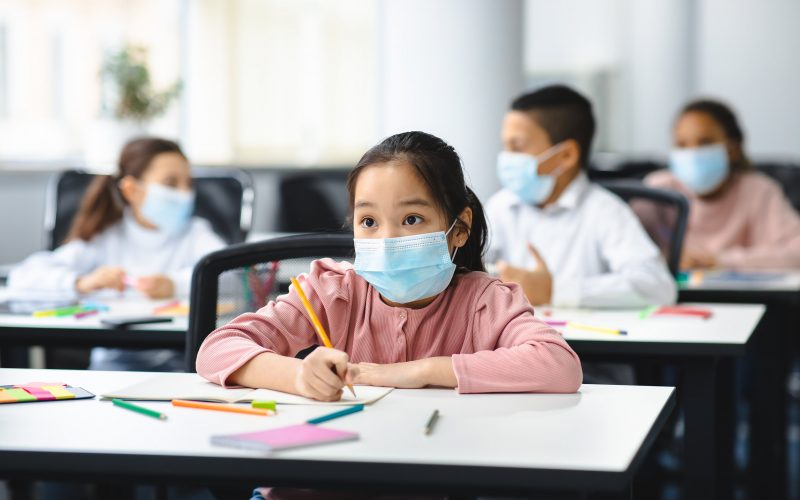Meta Analysis: Prolonged Mask Wearing May Lead To Health “Consequences In Many Medical Fields”
IN BRIEF
- The Facts:
- A large meta analysis has raised a number of health concerns with regards to prolonged mask wearing.
- The researchers outline concerning physiological and psychological outcomes that may result from prolonged mask wearing.
- Reflect On:Why is this side of the story never told by mainstream media? Are we really getting a proper representation of the science regarding the safety of prolonged mask wearing? Are those who make health policy aware of this research?
A large meta analysis published in the Journal Environmental Research and Public Health titled, “Is a Mask That Covers the Mouth and Nose Free from Undesirable Side Effects in Everyday Use and Free of Potential Hazards?” looked at 65 studies pertaining to prolonged mask wearing to examine whether or not there may be any health consequences.
Prolonged mask wearing is a new phenomenon, it’s something we’ve never really seen en masse before. Today, mask mandates are spread across the globe in multiple countries, mostly if you’re inside a public space, like a school, bank or business for example.
For workers who are not working from home, masks are still worn throughout the day in many countries around the world. Since the beginning of the pandemic a number of scientists and researchers have published papers in medical/scientific journals creating cause for concern around this practice.
Many even became quite active on social media expressing their concerns with mandatory mask measures as it pertains to human health and their doubts regarding efficacy, but they were heavily censored.
This article isn’t about the efficacy of masks. It’s about their safety. One of the challenges regarding commenting on their safety and/or efficacy these days is being labelled a “conspiracy theorist” for asking questions and presenting evidence that oppose the ‘official’ narrative.
We’ve seen experts in the field, like Dr. Carl Hennegan, an urgent care doctor and professor of evidence based medicine at the University of Oxford University be censored and criticized for sharing their opinion on these matters. This was the article censored by Twitter, among other social media outlets. This type of thing has happened to more than one hundred million pieces of content, and academics like Heneghan have been caught in the dragnet.
It would be great if there were some Randomized Controlled Trials regarding the efficacy of masks. But let’s focus on health and safety.
Safety concerns being raised about masks are what sparked mass ridicule from organizations like the Centres for Disease Control (CDC) and other government health authorities who claimed, and continue to, that prolonged mask wearing is completely safe and there’s nothing to worry about. But is that really true? How do we know? Are there any side effects? Isn’t it alright to question these claims?
Fact checkers continue to maintain that there is absolutely no danger associated with prolonged mask wearing. The next question then becomes, why are so many scientists allowed to publish this paper in a peer reviewed scientific journal if they are wrong?
According to the authors of the meta analysis:
Up until now, there has been no comprehensive investigation as to the adverse health effects masks can cause. The aim was to find, test, evaluate and compile scientifically proven related side effects of wearing masks. For a quantitative evaluation, 44 mostly experimental studies were referenced, and for a substantive evaluation, 65 publications were found. The literature revealed relevant adverse effects of masks in numerous disciplines.
In the paper the authors provide a wealth of data and evidence for psychological and physiological deterioration that are quite consistent, statistically significant, and measurable throughout multiple studies when it comes to extended mask use. They believe that “extended mask-wearing by the general population could lead to relevant effects and consequences in many medical fields.”
So where is the evidence? It’s outlined quite well in the paper. If you’d like to get a full scope of the health harms that can result from extended periods of mask wearing, I suggest you go through it. This article simply provides a brief summary, so it’s important to refer to the study.
The researchers discovered and confirmed that “relevant, undesired medical, organ, and organ system-related phenomena by wearing masks occur in multiple fields of internal medicine.” These fields are neurology, psychology, psychiatry, gynecology, dermatology, ENT medicine, dentistry, sports medicine, sociology, microbiology, epidemiology, pediatrics and environmental medicine.
They then go through each of these fields and explain what they found. There are clear, statistically significant, and concerning findings, especially when it comes to respiratory physiology.
For example, when it comes to the pediatric section, they explain:
Children are particularly vulnerable and may be more likely to receive inappropriate treatment or additional harm…Special attention must be paid to the respiration of children, which represents a critical and vulnerable physiological variable due to higher oxygen demand, increased hypoxia susceptibility of the CNS, lower respiratory reserve, smaller airways with a stronger increase in resistance when the lumen is narrowed. The diving reflex caused by stimulating the nose and upper lip can cause respiratory arrest to bradycardia in the event of oxygen deficiency.
In an experimental British research study, the masks frequently led to feelings of heat (p <0001) and breathing problems (p < 0.03) in 100 school children between 8 and 11 years of age especially during physical exertion, which is why the protective equipment was taken off by 24% of the children during physical activity.
Scientists from Singapore were able to demonstrate in their Ib study published in the renowned journal “nature” that 106 children aged between 7 and 14 years who wore FFP2 masks for only 5 min showed an increase in the inspiratory and expiratory CO2 levels, indicating disturbed respiratory physiology. However, a disturbed respiratory physiology in children can have long-term disease-relevant consequences. Slightly elevated CO2 levels are known to increase heart rate, blood pressure, headache, fatigue and concentration disorders.
It is also important to emphasize the possible effects of masks in neurological diseases, as described earlier. Both masks and face shields caused fear in 46% of children (37 out of 80) in a scientific study. If children are given the choice of whether the doctor examining them should wear a mask they reject this in 49% of the cases. Along with their parents, the children prefer the practitioner to wear a face visor.
A recent observational study of tens of thousands of mask-wearing children in Germany helped the investigators objectify complains of headaches (53%), difficulty concentrating (50%), joylessness (49%), learning difficulties (38%) and fatigue in 27 % of the 25, 930 children evaluated. Of the children observed, 25% had new onset anxiety and even nightmares. In children, the threat of scenarios generated by the environment are further maintained via masks, in some cases, even further intensified, and in this way, existing stress is intensified.
This can in turn lead to an increase in psychosomatic and stress-related illnesses. For example, according to an evaluation, 60% of mask wearers showed stress levels of the highest grade 10 on a scale of 1 to a maximum of 10. Less than 10% of the mask wearers surveyed had a stress level lower than 8 out of a possible 10.
As children are considered a special group, the WHO also issued a separate guideline on the use of masks in children in the community in August 2020, explicitly advising policy maker and national authorities, given the limited evidence, that the benefits of mask use in children must be weighed up against the potential harms associated with mask use. This includes feasibility and discomfort, as well as social and communication concerns.
According to experts, masks block the foundations of human communication and the exchange of emotions and not only hinder learning but deprive children of the positive effects of smiling, laughing and and emotional mimicry. The effectiveness of masks in children as a viral protection is controversial, and there is a lack of evidence for their widespread use in children; this is also addressed in more detail by the scientists of the German University of Bremen in their thesis paper 2.0 and 3.0.
Keep in mind that pediatrics is one of twelve areas where they found significant concerns. I suggest you refer to the study to go through the others.
This data is quite eye opening and really makes you wonder how well thought out these mandates are, and what long term consequences they could have. With very few paying attention to these concerns, if there are consequences of extended periods of mask wearing, will the connection between the masks and the consequences ever be made? Again, this may be difficult due to the ridiculing of any evidence, opinion, and discussion around this, which is why we have chosen to cover these topics.
As the researchers state:
Long-term disease-relevant consequences of masks are to be expected. Insofar, the statistically significant results found in the studies with mathematically tangible differences between mask wearers and people without masks are clinically relevant. They give an indication that with correspondingly repeated and prolonged exposure to physical, chemical, biological, physiological and psychological conditions, some of which are subliminal, but which are significantly shifted towards pathological areas, health-reducing changes and clinical pictures can develop such as high blood pressure and arteriosclerosis, including coronary heart disease (metabolic syndrome) as well as neurological diseases.
For small increases in carbon dioxide in the inhaled air, this disease-promoting effect has been proven with the creation of headaches, irritation of the respiratory tract up to asthma as well as an increase in blood pressure and heart rate with vascular damage and, finally, neuropathological and cardiovascular consequences . Even slightly but persistently increased heart rates encourage oxidative stress with endothelial dysfunction, via increased inflammatory messengers, and finally, the stimulation of arteriosclerosis of the blood vessels has been proven. A similar effect with the stimulation of high blood pressure, cardiac dysfunction and damage to blood vessels supplying the brain is suggested for slightly increased breathing rates over long periods. Masks are responsible for the aforementioned physiological changes with rises in inhaled carbon dioxide and small sustained increases in heart rate and mild but sustained increases in respiratory rates.
For changes that do not exceed normal values, but are persistently recurring, such as an increase in blood carbon dioxide, an increase in heart rate or an increase in respiratory rate , which have been documented while wearing a mask, a long-term generation of high blood pressure, arteriosclerosis and coronary heart disease and of neurological diseases is scientifically obvious. This pathogenetic damage principle with a chronic low-dose exposure with long-term effect, which leads to disease or disease-relevant conditions, has already been extensively studied and described in many areas of environmental medicine . Extended mask-wearing would have the potential, according to the facts and correlations we have found, to cause a chronic sympathetic stress response induced by blood gas modifications and controlled by brain centers. This in turn induces and triggers immune suppression and metabolic syndrome with cardiovascular and neurological diseases.
In summary, the authors feel that the typical conditions that have been documented include increase in breathing resistance, blood carbon dioxide, decrease in blood oxygen saturation, increase in heart rate, blood pressure, decrease in cardiopulmonary capacity, increase in respiratory rate, shortness of breath and difficulty breathing, headache, dizziness, decreased ability to concentrate and think and more. All these and more can lead to serious health outcomes.
Why This Is Important: This is important because long term mask wearing is being mandated and the health consequences may be significant for some. Questioning this helps us ask whether or not our government and health authorities are doing their due diligence when it comes to protecting our health.
One paper titled “Facemasks in the COVID-19 era: A health hypothesis” concludes:
Wearing facemasks has been demonstrated to have substantial adverse physiological and psychological effects. These include hypoxia, hypercapnia, shortness of breath, increased acidity and toxicity, activation of fear and stress response, rise in stress hormones, immunosuppression, fatigue, headaches, decline in cognitive performance, predisposition for viral and infectious illnesses, chronic stress, anxiety and depression. Long-term consequences of wearing facemask can cause health deterioration, developing and progression of chronic diseases and premature death. Governments, policy makers and health organizations should utilize a proper scientific evidence-based approach with respect to wearing facemasks, when the latter is considered as preventive intervention for public health.
The Takeaway: In an era where certain information is simply not presented to the masses, it’s important for various platforms to continue to share this information.
It’s very difficult to determine who is right or wrong, which is why we need open dialogue. The fact that simple discussion and pieces of evidence that change the narrative, or threaten it, are being shut down, censored, and completely ridiculed is a sign our collective sense-making is breaking down. The long term implications of this can be huge.
We are also seeing a great divide among the citizenry taking place as pockets of the population begin seeking more complete information. When things are not so cut and dry, are we making the right choice in giving governments the ability to control our lives in the manner they have done with this pandemic? It’s a tough question, but one worth asking.
At the same time, things are getting to the point where more information seems unhelpful. No matter how much information and evidence is presented to support a particular idea, we’re always left with a divide among people. Why? What is happening in our thinking processes to create this? Can we really blame it all on “fake news” or are we starting to realize there are other factors at play?
Right now, the mainstream narrative suggests level 1 thinking: go to war with the virus. It does not consider long term consequences or a holistic approach to all things societally. Is this really effective? Perhaps we’re being asked to mature in our thinking and decision making, and perhaps do away with authoritarian mindsets.
We are at the point where we must be able to respect other people’s choices and the actions they choose to take without enforcing these actions on others who disagree. This, more important than who is right or wrong, is where we must meet each other.




 thepulse.one
thepulse.one










